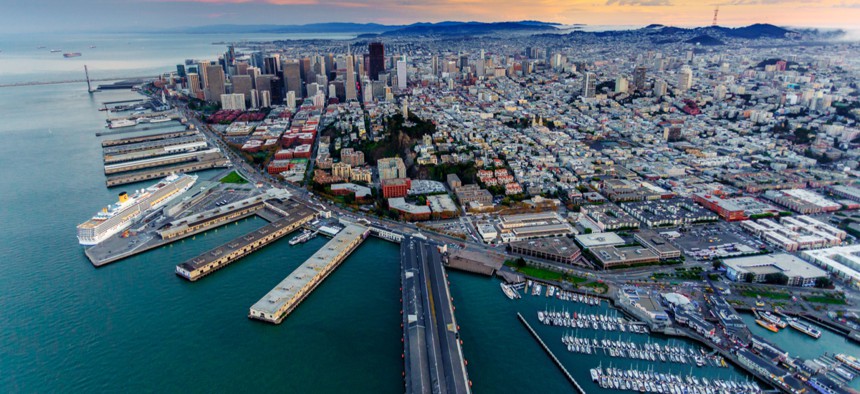More Money Than Anyone Imagined

Engel Ching/Shutterstock.com
A quick explanation for why the tech bubble never burst.
Eight years ago, we were in the midst of a frothy, frothy tech bubble.
It was all anyone could talk about—at investor conferences, in the pages of The New York Times and The Wall Street Journal, in notes by research analysts. “Irrational exuberance has returned to the internet world,” The Economist warned, in one of many stories on the topic. That late-1990s feeling was “back,” said Esquire, pooh-poohing LinkedIn’s business model and arguing that “American ingenuity and American gullibility” were thriving in Silicon Valley. This magazine was not immune to writing about it, nor was yours truly.
Then, poof! It was gone. The tech bubble did not burst. It simply disappeared as a matter of concern. Investors kept on investing. Valuations kept on rising and falling. Companies went public, got acquired, succeeded, and fell apart. The business commentariat moved on. But perhaps it should not have. The 2011 popless panic has something to tell us about ingenuity, investment, and how money gets made in Silicon Valley today.
Back then, the concern was that very little money was getting made at all. Investors were throwing billions of dollars at start-ups with scant or nonexistent revenue streams, producing obscene valuations. Snapchat, for instance, had a multimillion-dollar valuation with zero revenue, let alone profits, causing huge amounts of finger wagging and eyebrow raising.
It did not help that Silicon Valley and San Francisco started to feel—and very much still feel—detached from reality. Tech bros were disrupting eating disorders, taking hallucinogens to improve their productivity, and paying to freeze themselves so they could live forever, all while shelling out $2,000 a square foot for housing and taking private jets to go on vacation. The writers of HBO’s "Silicon Valley" found at least one real-life meeting with a denizen of Silicon Valley too absurd to be used as grist for the show. With the rest of the economy limping along, the Bay Area felt like Gomorrah before the fall. But the party just kept going.
It kept going in part because vastly more money was sloshing around than people initially realized. Source one for that cash: foreign investors, particularly ones based in China, Saudi Arabia, and Japan. Firms such as SoftBank have funneled astonishing sums into the pockets of start-up founders and early investors, helping prop up tech valuations and allowing early-stage investors to cash out. (It seems worth noting that tensions between Beijing and Washington have led to a collapse in Chinese investment in tech in recent months.)
Source two: the giants that form the highly profitable headwater of the broader tech ecosystem, such as Amazon, Google, and Facebook. These companies have flushed hundreds of billions down to smaller, younger firms and their investors in the form of acquisitions and acquihires. Facebook spent $20 billion on WhatsApp and Instagram; Microsoft spent $26 billion on LinkedIn and $7.5 billion on GitHub. Deals such as these were possible only because those acquiring companies were themselves so very profitable. More broadly, the tech dura-bubble has coincided with a continued boom in corporate profits that has lifted valuations and increased the sums spent on mergers and acquisitions through the whole economy.
All that capital from institutional investors, sovereign wealth funds, and the like has enabled start-ups to remain private for far longer than they previously did, raising bigger and bigger rounds. (Hence the rise of the “unicorn,” a term coined by the investor Aileen Lee to describe start-ups worth more than $1 billion, of which there are now 376.) Such financial resources “never existed at scale before” in Silicon Valley, says Steve Blank, a founder and investor. “Investors said this: ‘If we could pull back our start-ups from the public market and let them appreciate longer privately, we, the investors, could take that appreciation rather than give it to the public market.’ That’s it.”
Those private investors have, in turn, eaten the losses when start-ups have failed, as many of them have. There are fewer IPOs now than there were during the last, true tech bubble, and many venture-backed companies that have gone public have done so far later than they did the last time around. If there was a bubble and it were to burst, kitchen-table investors might scarcely notice, unlike in the late 1990s.
And what is there to burst? Some of the companies with those giant valuations have never turned a profit, most notably Uber. But many others have. It just took some time for them to grow and to monetize their user base, and thus to justify their valuations. Here’s how Esquire described LinkedIn back in 2011:
It provides people you don’t like enough to take a telephone call from or even answer an e-mail from a way to get in touch with you when they’re at their most boring and desperate—i.e., when they need a job … [This] company whose profits of $15 million would seem the very apex of its very limited potential was able to go public in May at the high end of its IPO price. And then almost triple on its first day of trading before closing at double. Yes, a company with $15 million of profits was valued at $9 billion.
The company today has half a billion users, and makes gobs of money by selling information about them, as well as by selling advertisements. It has more than $1 billion in revenue a quarter, and is owned by Microsoft. Being a giant sponge for salable personal information makes for good business, it turns out.
So does being a company growing in a low-interest-rate environment with heaps and heaps of private investment to go around. Bubbles are bubbles because they burst. For all the froth, there’s still no sign of that happening.





